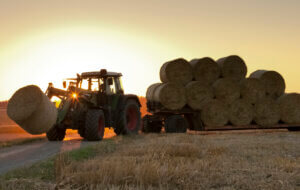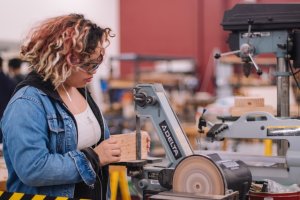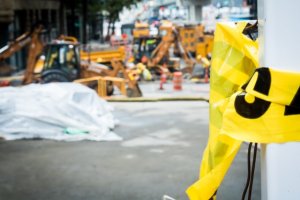Ladder Accident Claim
Ladder Fall Compensation
Falls from height can lead to life-changing injuries.
“Fielding a first class, very well resourced team of litigators, the personal injury department at Osbornes is rated for its diverse workload of complex, high-value injury claims.”
“They punch well above their weight. The quality of service they provide equals that of any of the larger top-name firms in this area.”
Introduction
Falls from height remain the most likely cause of death in the workplace and one of the main causes of serious injury and fatal injury claims. By 2006 the problem had become so great that the government introduced new regulations to improve worker safety.
Use of ladders in the workplace
Ladders are a common piece of equipment at work with employers because they are a cheap means of access – they do not cost much and can be used by one person without assistance. This means they can be used in situations where they are not up to the job.
They should only be used for jobs and on sites where an assessment has been carried out to make sure that scaffolding, a mobile platform or rope access should not be used instead. They should be ‘footed’ by a second person and safely tied and secured at the top. But these safety measures make them more expensive and less flexible, so workers are often sent out on jobs with just a job sheet and a standard-sized ladder.
Unsurprisingly the ladder will sometimes slip away from beneath because it is not secured at the bottom, or it may fall sideways because it was not secured at the top.
Another particular risk involves working on roofs. Sometimes the surface of the roof is fragile and unsafe. There may be a skylight window that is easy to step through. In these cases, the injuries are almost always severe and can involve head and spinal injuries as well as multiple fractures, but they are also usually preventable: a proper risk assessment will ensure that the strength of the roof is tested and weak areas cordoned off with barriers. Skylights should always have barriers around them which are marked.
The law relating to ladder accident claims
Work at Height Regulations
The Work at Height (amended) Regulations 2007 apply to all work where there is a risk of a person at work falling from a height, not just on construction sites but also in offices shops and other workplaces.
The regulations are widely drawn so that any work at height has to be assessed and if possible avoided; if it cannot be avoided then efforts must be put in place to minimise the risk. These efforts may include the use of safety equipment to prevent a fall or minimise the distance involved, or a properly documented procedure and proper training so that workers understand and can deal with any particular risks from the task they are carrying out. That safety equipment has to be inspected, maintained and repaired and the workers have to be trained in its proper use.
Practical measures may include grab and guard rails, toe holds, harnesses and netting, working platforms and hard hats.
The regulations also cover the use of ladders at work. Ladders are the cause of many accidents at work, and of the 6000 significant and major accidents reported to the Health & Safety Executive every year over 1000 involve the use of a ladder.
Ladder fall compensation case studies
£75,000 payout for labourer
Mr M, a 30-year-old labourer, fell through a glass atrium on the roof of the building where he was working, and landed on his feet, sustaining serious (‘trimalleolar’) fractures of the ankle. Because the fractures extended through the joints of the ankle it caused osteoarthritis and M was disabled by pain so he was unable to work for many months. As the arthritic disease progressed his mobility deteriorated so that after two years he required surgery to fuse the ankle joint. This improved the pain but did nothing for his mobility. He was then unable to work in heavy manual work that involved standing for long periods on walking along uneven ground, so he retrained for less physical, but less well-paid work.
Mr M was self-employed and had a patchy work history so there was a negotiation over his level of earnings and his future earnings differential. The case was settled after court proceedings for £75,000, to reflect the seriousness of the injury and the effect it had in the claimant’s employment prospects.
£30,000 to settle claim for labourer and handyman
Mr O was a labourer and handyman. His job involved some painting and decorating and maintenance work onsite for a client. His employer assessed the job and priced it on-site, before giving Mr O a job sheet. Mr O had access to the client’s tools and materials and needed to use one of his ladders to access an elevated pedestrian walkway from the ground below. He had nobody to hold the ladder at the bottom, even though the ground surface was smooth, and no means of fixing it at the top.
His employer knew that the job required Mr O to work at height but provided no equipment at all and failed to come up with any safe way of doing the job.
Mr O was working near the top of the ladder when, as he adjusted position slightly, it suddenly slipped away at the bottom and he fell about 8 feet to the ground. He broke his hip and wrist and suffered a lot of soft tissue damage which took many months to heal.
The employer’s insurers defended the claim initially but finally gave in to prevent the case going to court, and they paid over £30,000 to settle the claim for Mr O’s injuries, loss of earnings care and expenses, together with all the legal costs.
Specialist advice for Ladder Accident Claims
At Osbornes Solicitors we have dealt with many cases of workers falling from or through the roof of buildings because their employers did not take the elementary steps necessary to prevent accidents at work.
By choosing Osbornes Law for your claim, you will benefit from:
- Support in every aspect of your claim – our service goes beyond just handling the legal aspects of your claim. We work with a network of healthcare professionals, charities and support groups to ensure that you are connected to the best possible services while we fight for your right to compensation.
- Expertise – our accident solicitors have extensive experience in handling claims involving all types of injuries. We understand the complexities involved and know how to build strong, evidence-based cases that maximise your chances of success.
- Personalised service – Our team is always available to answer any questions you may have and provide support every step of the way.
- No-win no-fee – injury claims can usually be funded through a no-win no-fee agreement. This means that you will not have to pay any upfront fees or legal costs unless we win your case.
If you work or worked in construction and experienced an injury after falling from a ladder or from a height, contact our specialist team of lawyers who can advise you on whether or not you are eligible to claim accident compensation. We have over 50 years experience in helping our clients bring and win claims for compensation. Our lawyers focus on achieving the best medical, care and financial award.
“Osbornes has an impressive social housing team and the quality of their work that I have seen is very high. Will Ford is a very well-regarded figure in the housing law world and leads a team of high quality and committed lawyers. The existence of family and property law teams at the firm, amongst others, means that they are able to offer a holistic and expert approach to their clients.”
“Shilpa was very diligent in her attention to detail and her pursuit of all necessary documentation; she showed great determination in the face of many requests by the other party’s solicitor to let certain things slide. She was thorough and professional which gave us a great sense of security.”
I would highly recommend Osbornes Solicitors, especially Manjit Mandair who worked so diligently on my behalf and came to a happy conclusion.
At each juncture Yael has provided me with clear information and advice, and each time she has obtained results that have prioritised the well being of myself and my son.
Will is a very down-to-earth guy who produces really fantastic work; it is a joy to work on cases with him
Client Stories & InsightsVIEW ALL
- 13.3.2024
Accident at Work Compensation Examples
Factory Worker Receives £14,000 for Hot Water Burns Our client was working in a food producing factory. He was injured when...
Read more - 11.4.2023
£250,000 settlement for client injured in forklift accident
Sophie Davies, a specialist personal injury lawyer at Osbornes Law, recently represented a client who suffered life-changing injuries following a...
Read more - 17.11.2021
£100,000 settlement for tripping at work
Osbornes Law secures £100,000 settlement for Hungarian woman who tripped over a shopping bag at work Siobhan McIvor, a Partner in...
Read more - 17.11.2021
£165,000 settlement for factory accident
Siobhan McIvor, a Partner in the Personal Injury Department of Osbornes Law, has settled a £165,000 accident at work claim, with...
Read more - 31.8.2021
Kitchen Accident Claim
Our client, a hospitality supervisor instructed Osbornes after he slipped and fell on oil and food debris on the floor...
Read more - 18.5.2021
Construction Site Accident at Work
Our client suffered numerous fractures to their left leg requiring surgery following a work accident on a construction site. He...
Read more - 18.5.2021
Compensation for Amputation on Construction Site
Our client worked as a carpenter/bricklayer on a building site at a residential property in North London. He was...
Read more - 15.10.2020
Fatal Accidents In The Workplace
A new article from the BBC takes a looked at fatal accidents at work. The report states that since 1981, there...
Read more - 2.9.2020
Lasting damage to ankle following construction accident settles...
Sam Collard, a Partner in the Osbornes’ catastrophic injury team, recently settled a construction accident claim for a Romanian man...
Read more - 13.8.2019
Fatal Accident Conviction Highlights Health & Safety
Construction bosses guilty of gross negligence manslaughter Conrad Sidebottom, 46, and Richard Golding, 43, were jailed for their part in causing the...
Read more
Our Personal Injury Team View the whole team
Rob Aylott
Partner
Personal Injury SolicitorsSam Collard
Partner
Personal Injury SolicitorsSophie Davies
Partner
Personal Injury SolicitorsLaura Swaine
Associate Solicitor
Personal Injury SolicitorsNicola Hall
Associate Solicitor
Personal Injury SolicitorsAndrew Middlehurst
Associate Solicitor
Personal Injury SolicitorsView the
whole team











